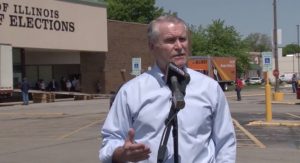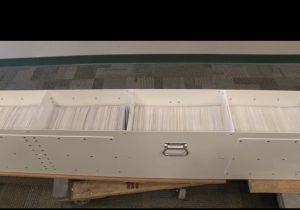State legislative mapping reformers deliver petitions to Springfield
Jean Lotus — May 11, 2016
A semi-truck containing a most 600,000 citizen signatures is parked in front of the Illinois State Board of Elections in Springfield Friday.
A truckload of 65,261 Independent Map Amendment citizen petition pages was unloaded at the Illinois State Board of Election offices in Springfield Friday — just in time for the deadline to get a district map reform referendum on the Nov. 8 ballot.
The petitions had nearly twice the minimum number of signatures needed, said Dennis FitzSimons, chair of the Independent Maps Coalition, which calls itself a nonpartisan reform organization.
“Today, legislators are in charge of drawing the boundaries of their legislative districts. After this amendment becomes law, those maps will be drawn by an independent commission consisting of a diverse group of citizens from all areas of the state,” FitzSimons said.

David FitzSimons of Independent Maps Coalition
Illinois legislative districts are redrawn by the majority in the General Assembly every 10 years after the U.S. Census is released. Called an “incumbent protection program” legislative maps have been stretched and shifted to rope in similar voters, split up communities and even remove lawmakers from their own districts.
Both Democrats and Republicans have engaged in creative cartography when they had the majority. For example, during the last legislative remapping in 2011, Rockford Republican State Sen. David Syverson was drawn out of his own district (the 34th) and had to run in the 35th District — which stretched to Kane County — or move.
In 1991, Republicans split up the cities of Champaign and Urbana into different legislative districts, which included rural and more Republican-leaning voters.
Even President Barak Obama chastised the Illinois General Assembly for its convoluted mapping when he visited earlier this year.
“In America politicians shouldn’t pick their voters, voters should pick their politicians,” Obama said in Springfield.
In the upcoming election, seven out of 10 state legislative elections have a single candidate on the ballot, the group said.

Pages of petitions are submitted to the state board of elections.
The Illinois Campaign for Political Reform approves of the Independent Maps initiative, based on research they’ve done in other states, such as California and Arizona that enacted boundary reforms. The secret is lots of public input, said Executive Director Sarah Brune.
“It’s abundantly clear the citizens of Illinois want legislative boundaries to be drawn in a fair fashion,” she said.
That means getting it out of the hands of politicians, the group believes.
“Independent Maps takes the legislature out of the process,” said Kent Redfield, a professor emeritus of political science at University of Illinois Springfield, and a researcher on partisan mapping.
Last time a citizen-led movement arose to amend the constitution in 2014, election lawyers challenged signatures and had petitions thrown out. Independent Maps submitted 570,000 registered voter signatures this time. Only 290,216 signatures were required by law.
The Illinois Constitution has simple rules for legislative districts: they must be contiguous, compact and have equal population. But legislators and others say district boundaries should do other things: for example, guarantee minority representation.
Independent maps aims to add criteria to the rules: Districts must be drawn to group together units of government and “communities of interest” (meaning towns or neighborhoods with similar populations, Redfield said). Boundaries must also reflect minority representation. The boundaries are prohibited from being drawn based on partisan or incumbent consideration.
“The rule prohibits you from trying to protect or punish an incumbent,” Redfield said.
Independent Maps proposes an 11-citizen-panel, vetted and then winnowed by lottery. The coalition will be starting an education campaign, they said.
Members of the General Assembly also seemed to wake up to voter interest in legislative mapping this spring. Two bills in the House and State Senate were proposed to put legislative map reform on the ballot and quickly passed through each chamber. But then legislators missed the six-month deadline to pass the bills to get the initiative on the ballot.
“Now they can say they voted for redistricting reforms,” Redfield said.
Independent Maps will start a statewide education campaign to let voters know what will be on the ballot, they said.
“Voters are eager to make this reform a reality,” said FitzSimons. “They are tired of voting in uncontested elections where only one candidate is on the ballot in a district where the outcome is predetermined by the politicians drawing the maps.”



